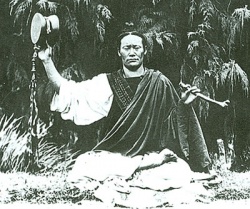The General Features of Tibetan Buddhism
Twelve centuries after the death and final enlightenment of the historical Buddha (c. 500 BC), the religious tradition bearing his name crossed over the Himalayan mountains and entered Tibet. From the early seventh century onward, Buddhism became firmly entrenched in all aspects of Tibetan society. This wholesale transformation of Tibet, however, was not entirely without its conflicts. When Buddhism first reached Tibet, it encountered what appeared to be an older indigenous religion commonly referred to as Bon. The Bon religion is believed to have originated in the ancient land of Tazig (referring generally to the direction of Persia). From there the religion took root in the Zhangzhung Valley, located in western Tibet near Mount Kailash, and ultimately spread eastward.
The nature of this ancient Bon, founded by Tönpa Shenrab (sTon pa gshen rab, "The holy teacher Shenrab"), is difficult to assess since no written records from the period have survived. The oldest extant Bon scripture dates from the late ninth century, long after Buddhism had already pervaded nearly every aspect of Tibetan culture. The early confrontation of the two traditions fundamentally altered much of the Bon religion, especially its monastic institutions and metaphysical doctrines, making it almost unrecognizable as a separate entity apart from Buddhism. Nevertheless, the claim of Bon-po ("followers of Bon") and of Tibetan Buddhists alike--that the Bon religion possesses its own distinctive identity--must be respected and taken seriously. The tradition has survived and indeed to some extent continues to flourish not only in Tibet itself, but also in Nepal, India, Europe, and the United States. Several significant examples of Bon literature and art are included in our exhibit, together with works of the better known tradition of Tibetan Buddhism. The foundational doctrines of Tibetan Buddhism are derived from the words taught by the Buddha almost two thousand five hundred years ago. The basic teachings of the Buddha (the so-called Four Noble Truths) begin with a recognition of the discomforts and frustrations of normal human existence. It is taught that the source of this frustration and distress does not rest in the nature of the world or in the mysterious intentions of a divine being, but rather in the intellectual and emotional confusions of human individuals themselves. Buddhism maintains that the suffering experienced in life can be completely uprooted and eliminated by clearing away these confusions, and prescribes specific methods for the successful accomplishment of this goal. Basic Buddhist practice, therefore, consists of following a disciplined path of intellectual and spiritual development requiring the radical examination of one's existential situation and profound and persistent changes in one's attitudes, behavior, and psychological orientation. The ideal Buddhist practitioner adheres to a strict moral code, trains rigorously in meditation, and endeavors tirelessly to develop compassion and insight.
Philosophically speaking, the confusions that function as the source of worldly suffering operate more precisely as innate misapprehensions with respect to the status of the individual self and of the surrounding world. This innate sense of self and other, including inanimate objects, involves the seemingly natural tendency to view things as solidly concrete, as more or less substantial and permanent. This means that ordinary people have a subtle sense of things as being constant through time, changeless and secure. Buddhism maintains that this perspective is profoundly mistaken. In reality, everything is changing, nothing is as it was even a moment before. Existence is forever in flux. As a consequence of the misperception of the truth of change and impermanence, human beings become mired in a cycle of pain and disappointment. Moreover, the false view of permanence engenders strong attachments and aversions, which in turn generate a host of destructive emotions such as jealousy, pride, and selfishness, all born of the fear of losing what is valued and of gaining what is scorned. This enduring round of pain and disruptive emotion is called samsara, and the ultimate goal of Buddhist practice is to liberate oneself from its negative bonds. Liberation from the cycle of samsara is achieved in part by readjusting one's fundamental perspectives, by developing the correct view of impermanence.
